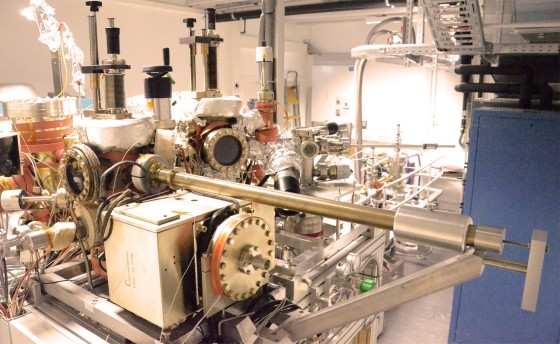Design and construction of a test stand for photocathode research and experiments
Konstruktion und Bau eines Teststands für Photokathodenforschung und Experimente
PhD thesis
Within the scope of this thesis, a test stand Photo-CATCH for research on semiconductor photocathodes used at the spin-polarized electron injector of the superconducting Darmstadt electron linear accelerator S-DALINAC is constructed and brought into operation. Ultra-high vacuum conditions are achieved in all parts of the system. Atomic-hydrogen assisted low-temperature cleaning of cathodes in a chamber with base pressure better than 3 x 10-11 mbar is used for preparing clean cathode surfaces for negative electron affinity (NEA) activation. Using a standardised activation procedure, atomic-hydrogen cleaning of heavily contaminated bulk-GaAs samples is optimized to an upper limit of 10 kL hydrogen-dosage. Cleaning of samples has been performed with a dosage as low as 0.7 kL. Activation of photocathodes with Cs+O2 and Cs+Li+O2 have been studied in a dedicated vacuum chamber with base pressure better than 2 x 10-11 mbar. By using a 405nm laser, quantum efficiencies above 25% have been achieved from an NEA-GaAs photocathode. Oxygen-induced quantum-efficiency degradation of NEA cathodes has been investigated. A vacuum lifetime of (298±35) hours was observed in the activation chamber for a novel two-stage activation using Cs, O2 and Li. This system can provide photocathodes with high quantum efficiency and lifetime for polarized and unpolarized beam production at the 60 keV electron beamline of Photo-CATCH. Additionally, atomic-hydrogen cleaned cathode samples can be transported to the photoelectron source at S-DALINAC using a transport-vessel conceptualized in this work.
Publications
- Kurichiyanil, Neeraj; Eckardt, Christian; Enders, Joachim; Espig, Martin; Fritzsche, Yuliya; Wagner, Markus; Aulenbacher, Kurt: Performance of and atomic hydrogen cleaning for semiconductor-photocathodes at the S-DALINAC. Verhandlungen der Deutschen Physikalischen Gesellschaft; ISSN 0420-0195; Worldcat; CODEN VDPEAZ; (Mainz 2012 issue); [1 p.]


